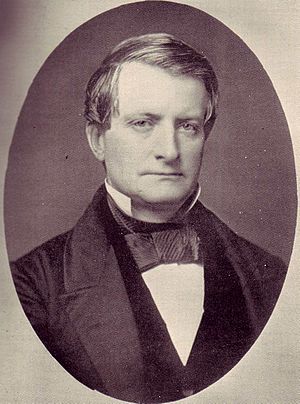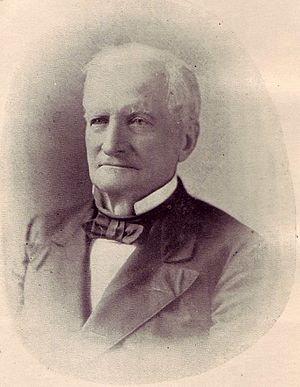Richard Peters (Atlanta) facts for kids
Quick facts for kids
Richard Peters
|
|
|---|---|

Richard Peters in 1848
|
|
| Born | November 10, 1810 |
| Died | February 6, 1889 (aged 78) |
| Resting place | Oakland Cemetery |
| Occupation | American businessman |
| Spouse(s) |
Mary Jane Thompson
(after 1848) |
| Parent(s) | Richard Peters Abigail Willing Peters |
| Relatives | Richard Peters, Jr. (grandfather) Joseph Thompson (father-in-law) |
Richard Peters (November 10, 1810 – February 6, 1889) was an important American businessman. He was a key figure in building railroads and helped found the city of Atlanta, Georgia, in the 1840s. Peters played a big part in developing Atlanta from a small railroad town into a major city.
Contents
Early Life and Education
Richard Peters was born on November 10, 1810. His birthplace was near Philadelphia in a place called Germantown, Pennsylvania. His parents were Ralph Peters and Catherine (Conyngham) Peters. His grandfather, Judge Richard Peters Jr., was a well-known person who worked with George Washington.
Young Richard Peters went to school in Philadelphia. He learned about building and design by working with a famous architect named William Strickland. He also worked as a surveyor, which means he measured land. This job helped him learn about building large projects like railroads.
Starting a Career in Railroads
In 1834, when Richard Peters was 26, he got a big opportunity. A man named John Edgar Thomson, who was impressed with Peters's work, offered him a job. Peters became the chief engineer for the new Georgia Railroad. This was a very important job at the time.
In February 1835, Peters traveled to the railroad construction site near Charleston, South Carolina. He worked hard on the Georgia Railroad for eight years. This railroad connected Augusta to a new town that would later become Atlanta. During this time, he became good friends with Lemuel Grant. Both men bought land in the new town, which was a smart move for their future.
When the railroad was finished, Peters was promoted to superintendent. This meant he was in charge of running the railroad. People often complained about the town's original name, Marthasville, because it was too long to write. Peters talked with John Edgar Thomson about it. When Thomson suggested the name Atlanta, Peters quickly printed many flyers. He spread the word about the new name from Augusta all the way to Tennessee. The town's name was officially changed to Atlanta in December 1845.
Developing Atlanta
Richard Peters was a true pioneer in Atlanta. He built the city's first steam-powered factory, which was a flour mill. It was located near the Georgia Railroad tracks. Since there was no water power, the mill used wood for fuel. Peters bought a large area of land, about 405 acres (1.6 km²), for $2,000. He used this land to grow pine trees for the mill's fuel. This area later became what is known today as Midtown Atlanta. Developing this land was a key reason for Peters's future wealth.
Peters was always interested in transportation. He even ran a stagecoach line between Atlanta and Montgomery, Alabama. After the Atlanta & West Point Railroad was completed, he moved his stagecoach line to connect with it.
He also loved farming and gardening. In 1854, he started a plant nursery in Atlanta.
The Civil War Years
In 1861, as the American Civil War began, Peters sold the steam engine from his mill for $12,000. It was used to make gunpowder for the Confederate army in Augusta. Peters became the civilian transportation agent for all Atlanta railroads. These railroads were vital for supplying the Confederacy with goods. He also worked with a company that helped bring supplies into the South, trading cotton for food.
Peters stayed in Atlanta until just before Union General Sherman's army arrived. By the time of the Battle of Atlanta, he and his family had moved to Augusta. They stayed there until April 1865.
After Sherman left Georgia in December 1864, Peters worked to repair the damaged railroads. He hired people to fix the Atlanta and West Point Rail Road, and his friend Lemuel Grant helped repair the Georgia Railroad. By April, the war was over, and train service was back in Atlanta.
Rebuilding Atlanta After the War
After the war, Peters continued to help Atlanta grow. In 1871, he built Atlanta's first street railway, the Atlanta Street Railway Company, with a real estate developer named George Adair. This made it easier for people to travel around the city.
When the Kimball House, a major hotel and center of Atlanta life, burned down, Peters helped lead the effort to rebuild it. He invited the original builder, Hanniball Kimball, back to town to help raise money.
As many new people moved to Atlanta, Peters started to divide his large land holdings in north Atlanta into smaller lots for homes. He created new roads, naming the north-south streets after trees like myrtle and juniper. He also named a street Penn, remembering his home state of Pennsylvania. The east-west streets were numbered, starting with 3rd Street.
He built his last home on the highest part of his land, between Peachtree, 4th, Cypress, and 5th streets. In 1887, he sold some of his land to the state for $10,000 and gave another four acres for free. This land helped start the Georgia School of Technology, a major university today.
Family Life
In 1848, Richard Peters built a home in Atlanta. He married Mary Jane Thompson, who was the daughter of an early settler and doctor, Joseph Thompson. Richard and Mary Jane had several children together. Their children, including Richard, Edward, Ralph, and Nellie, all became important people in their own right.
Richard Peters passed away on February 6, 1889. He was buried in Oakland Cemetery in Atlanta, a historic cemetery where many important Atlantans are laid to rest.
Richard Peters's Legacy
Richard Peters left behind a large estate, showing how successful he was. His son, Edward, stayed in Atlanta and built a beautiful home called Ivy Hall, which is now a historic landmark. Another son, Ralph, moved to New York and became the president of the Long Island Rail Road. Richard Peters's vision and hard work were crucial in shaping Atlanta into the major city it is today.
Images for kids




